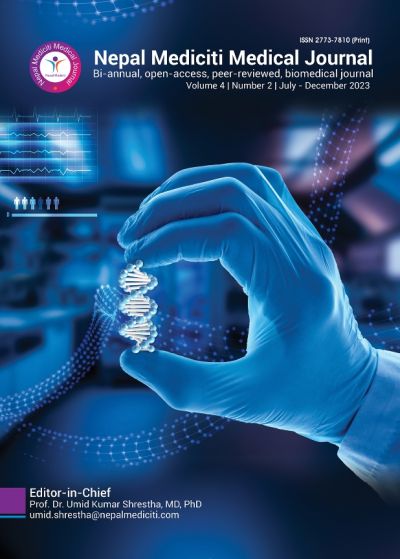Single surface phototherapy with reflecting curtains versus double surface phototherapy in unconjugated neonatal hyperbilirubinemia in a tertiary care NICU
DOI:
https://doi.org/10.3126/nmmj.v4i2.61889Keywords:
Single surface phototherapy, reflecting curtains, double surface phototherapy, unconjugated neonatal hyperbilirubinemiaAbstract
BACKGROUND Neonatal hyperbilirubinemia is treated with different modalities like single, double surface phototherapy and biliblankets. Reflecting curtains with single surface phototherapy is a cheaper and easy modality . So, this study was designed to compare the efficacy of single surface phototherapy with reflecting curtains [SSPRC] versus double surface phototherapy [DSP].
METHODS A prospective comparative study in 120 term neonates with unconjugated hyperbilirubinemia was conducted from July 2021 – Jan 2022 in Neonatal intensive care unit of College of Medical Sciences, Bharatpur. The study population was randomized to either SSPRC or DSP. The primary outcome was mean decrease and rate of decrease of bilirubin in subsequent 6 and 12 hours. Secondary outcome were duration of phototherapy and complications. The analysis was done using SPSS version 18.0.
RESULTS Mean bilirubin level at 6 hours after starting phototherapy was 16.27 mg/dL vs 16.71 mg/dL, p=0.542 and at 12 hours 14.61 mg/dLvs 14.70 mg/dL, p= 0.428. Mean rate of decrease in SSPRC vs DSP was 1.63 mg/dL vs 1.81 mg/dL, p=0.154 at 6 hours, 3.29 mg/dL vs 3.82 mg/dL, p=0.39 at 12 hours. Mean duration of phototherapy was significantly lower in SSPRC 3.8 Vs 4.2 days, p=0.031.Complications were skin rashes 11.7% vs 16.7%, p=0.432 and change in frequency of stool 10.0% vs 8.3%, p=0.752.
CONCLUSION Single surface phototherapy with reflecting curtain as double surface phototherapy is equally effective, reliable and successful in decreasing bilirubin in less duration with minimum complications. Therefore this technique can be of help where DSP is unavailable or unaffordable.
Downloads
Downloads
Published
How to Cite
Issue
Section
License

This work is licensed under a Creative Commons Attribution 4.0 International License.
This license enables reusers to distribute, remix, adapt, and build upon the material in any medium or format, so long as attribution is given to the creator. The license allows for commercial use.

